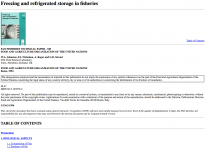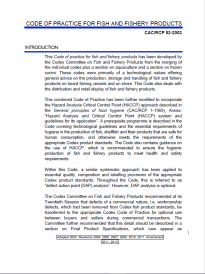Application of Appropriate Technology for Cold Storage
There are many options for cold storage technology, which range from small walk-in cold rooms to large-scale commercial refrigerated warehouses. Cold stores are land based and used on fishing vessels that catch and freeze fish as well as factory vessels. Key basic components of cold storage technology include the insulated room, flooring, refrigeration system, temperature monitor equipment and lighting. Total construction and operating costs for refrigerated systems vary widely depending on the costs of local materials, labour and electricity. Containerized cold stores also exist in some areas, are portable and can be rented or purchased.
While food loss and waste (FLW) can be reduced with the use of cold storage, the return on investment (ROI) for any specific operation will always depend largely upon the market value of the fish being cooled and stored and the use efficiency of the facility (i.e. whether or not it is operated at full capacity). The International Association for Cold Storage Construction provides a useful entry point to information on cold storage and the sector.
Cold Storage Technology Guidance
Cold Storage Technology Guidance
Reducing temperature fluctuations, dehydration, malfunction of the equipment, and warming the internal temperatures of the store are key FLW controls. The following provides specific guidance to help reduce the risk of FLW during cold storage:
- Cold stores require regular and proper maintenance. This is important if they are to run effectively and continuously.
- Always ensure products are properly frozen and at the correct temperature before they enter the cold store.
- Stack products according to a ‘first in first out’ approach and ensure there is good air circulation all around.
- Do not stack goods directly on the cold store floor, or close to the walls; leave an air space below and around the goods so that cold air can pass between the goods and the store structure. Pallets can be used on the floor, and vertical battens can be fixed to the walls. Products should be at least 10 cm off the floor, 20 cm away from walls and 45 cm from roof cooling units, and that 2.5 cm dunnage (loose material/packing) should be used between every second tier of packages.
- Produce stacked close to the doorway should be screened to protect it from warm air coming in.
- Avoid freezing air from the evaporator coils going directly to the product. Consider installing a restraining device under the coils to deflect cold air.
- Malfunctions occur if a switch is broken, there is a loose connection from the power source, an unsuitable line voltage or a circuit breaker is not working. In the event of equipment breakdown, seek the help of a qualified electrician.
- Avoid any warming of temperature in the area of the product and warm products coming in contact with already frozen products.
- Never attempt to freeze fish in a cold store and never put frozen fish that is warmer than the store directly into the store. Cold storage plant rarely has sufficient reserve capacity to cope with the extra heat load; warm produce brought into the store will not only take a very long time to cool, but can also warm other products already in store, with consequent loss of quality.
- Make sure defrost drain tubes are not leaking and dripping melt water onto the products. All cooling pipes in the store should be defrosted at regular intervals (efficiency of the cooler will be considerably reduced if frost is allowed to accumulate).
- Internal temperature can rise if the refrigeration unit is not sufficient to cope with the volume of stored products. Temperature rise can also occur in hot weather or if the airflow is not suitable for the room size. (These problems can be avoided if the correct refrigeration cooling capacity has been installed and appropriate walling and roofing materials have been used in construction.)
- Never have more than one door open at a time, and do not leave it open longer than necessary.
- All products in store should be protected either by a wrapping that is impervious to water vapor, or by adequate glazing; glazing should be renewed at intervals when required.
- Samples of products in store should be inspected at regular intervals and their temperature checked.
- Store air temperature should be continuously recorded, and checked at regular intervals; any movement outside the tolerated limits should be immediately reported so that action can be taken to put things right.
Cold Storage Temperature
Cold Storage Temperature
In conventional cold stores, the temperature adjustment and storage method depend upon the experience of the operator. This requires the operator to be physically present at the cold storage to adjust the temperature and manage the system by periodic measurement. However, negligence and inaccuracy due to human intervention can result in product spoilage. Electronic management systems and controllers assist by controlling the storage environment automatically, with the pre-set values which help in precise control, food safety and compliance. Electronic sensors help maintain precise conditions/temperatures. A remote monitoring capability provides the user with the ability to control the system from any place, instead of remaining at the site all the time, while also maintaining a log of data for easy analysis. Remote monitoring and preventive maintenance can further help reduce operating costs as well as FLW.
Green Technology
Green Technology
In terms of green technology, solar powered cold storage is available. For example, in Ghana, the Wegdam Food Link BV company officially opened a 5000MT solar powered cold store unit in Tema in 2016.
Chilling and the Use of Ice
Chilling and the Use of Ice
Innovative relatively low cost small-scale mechanical cooling/chilling technology includes the CoolBot™, a cold room for storage of chilled food products. With an achievable low temperature of 2.2 to 4.4°C, this technology is not for cold storage of frozen product but relevant for chilled fish on ice or controlled thawing of frozen product.
Key Publications
Freezing and Refrigerated Storage in Fisheries This FAO publication provides an introduction to the operations and equipment used in fish freezing and cold storage on shore and sea, and gives information on applying low temperatures to reduce deterioration of quality. | |
This document describes changes that can occur in cold storage, effects of time and temperature on protein, factors limiting storage life, and emphasizes the need to store frozen fish and products at -30°C. | |
Code of Practice for Fish and Fishery Products CAC/RCP 52-2003 Global standard that presents information on freezing and cold storage practices which aim to reduce spoilage and waste. |
More Resources
More Resources
31 October 2023
05 September 2023














